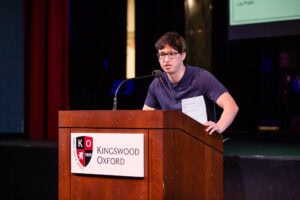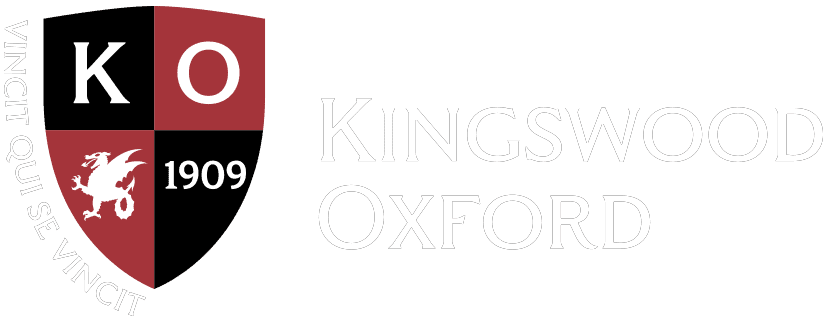September 25, 2025
Living Latin
Step into James Ishiguro’s Latin classroom at Kingswood Oxford Middle School, and you’ll find an environment that feels alive with creativity, curiosity, and history. For Ishiguro, teaching Latin is far from a static exercise in memorization; it’s an immersive journey that allows students to build, imagine, and connect across centuries. His teaching philosophy is rooted in giving students agency and variety.
“I give students a lot of creative outlets,” Ishiguro explains. “I want my classes to feel different and unique every day. Some days that means analyzing historical videos, other days it means working on collaborative projects or designing their own models of ancient structures. It’s about reaching every type of learner.”
That blend of approaches helps students engage deeply with a subject that, at first glance, might seem far removed from modern life. Ishiguro is quick to counter the question he hears most often: “Why study Latin?” His answer is multifaceted.
“Almost 70% of English is derived from Latin,” he says, “so learning it improves how we write, read, and communicate in our own language. But classics as a field is also interdisciplinary. It gives students tools for success in history, English, and even modern languages. There’s so much in Roman history that still shapes the world around us.”
At the same time, Ishiguro recognizes that the classics can’t just be told through a Roman lens. He embraces a curriculum that includes the diverse civilizations Rome touched, from Britannia and Gaul to North Africa and modern-day Turkey and Iraq. “When I was a student, those cultures were often covered only on the surface,” he reflects. “Now I want my students to see a fuller, more global picture.”
A strong emphasis on creativity and critical thinking matches this broadened perspective. Ishiguro often tasks middle school students with recreating monuments like the Circus Maximus or Roman baths, encouraging them to learn by building. These projects blend history with design, storytelling, and problem-solving, helping students absorb material in ways that stick. “I think giving kids freedom to construct, imagine, and collaborate brings history off the page,” he says.
Though Ishiguro never initially planned on teaching—he thought he might work in publishing, a library, or even a field that let him travel—he’s discovered a vocation that feels both meaningful and natural. Now in his third year at KO, the only school where he has taught, he feels grateful for the chance to make a tangible impact. “I think it’s okay if students don’t remember every detail of Latin years later,” he says thoughtfully. “What matters is that they leave with skills—communication, comprehension, collaboration—that will serve them for life.”
That philosophy has resonated with students and parents alike, who frequently express their gratitude during events and curriculum nights. Those affirmations, whether casual comments or heartfelt thanks, serve as powerful reminders of the reach and significance of his teaching.
Beyond content, Ishiguro finds joy in the relationships he builds. He sees students not just as Latin learners but as individuals with passions outside the classroom—artists, athletes, musicians. “It’s easy to forget that students have these whole worlds beyond our subject,” he says. “Watching them grow in their hobbies and interests inspires me as much as I hope I inspire them.”
Interestingly, his Latin classes remain deliberately low-tech. While he acknowledges the benefits of AI and digital tools, he prefers to focus on pencil, paper, and the whiteboard. “Latin is a language best learned through direct engagement with text,” he explains. “For me, limiting computers helps preserve the focus and depth the subject demands.”
One of the things Ishiguro values most at KO is the chance to work with both middle and upper school students. He appreciates the energy and joy that middle schoolers bring to learning, while also relishing the more nuanced discussions possible with upper schoolers. “Having that mix keeps me balanced,” he says. “Each age group brings something special.”
Teaching, for Ishiguro, is also a practice of continual growth. He draws inspiration from observing colleagues across disciplines and experimenting with new approaches. His involvement in extracurriculars, including helping lead Model UN and skills incubators, keeps his work dynamic. “One of the reasons I appreciate working here so much is to be a teacher, it’s not just teaching your students. It’s an opportunity for me to grow and continue learning as a language student myself. In that way, it doesn’t feel like a job. It’s almost like I’m continuing my studies.”
At the end of the day, what keeps Ishiguro motivated is the knowledge that he is helping shape not just scholars but well-rounded individuals. “Even if they don’t remember every Latin translation years from now,” he says, “I hope they’ll remember the skills, the curiosity, and the sense of wonder they built here.”
For Ishiguro, teaching Latin is not a job to check off each day—it’s a lifelong learning experience he shares with his students. And it’s that shared journey, one that blends history with creativity and personal growth, that makes his classroom such a vibrant space within the KO community.
James Ishiguro
Colby College, B.A.
Trinity College Dublin, M.A.
Profiles Main News
